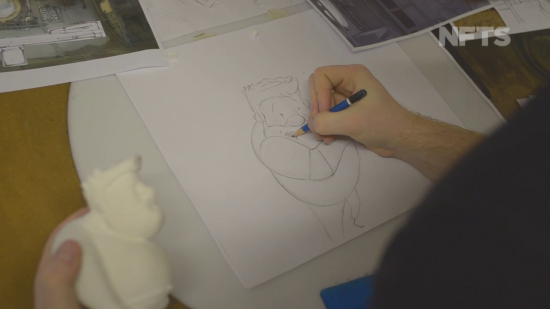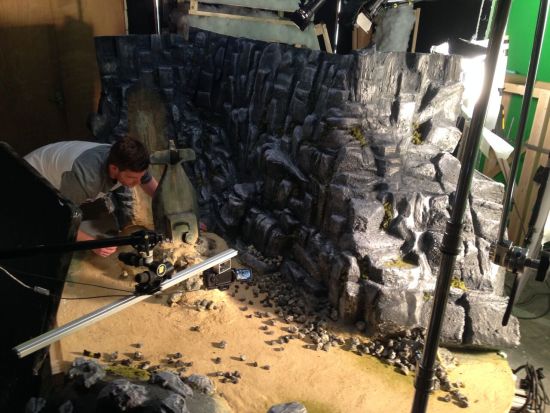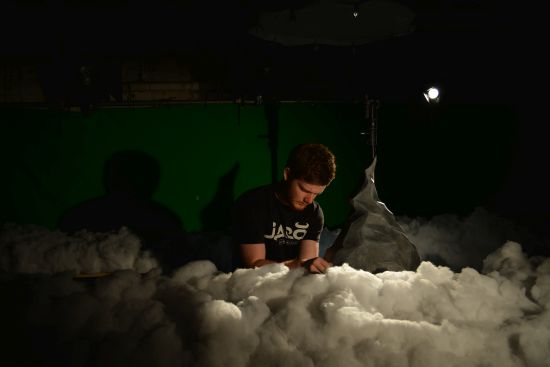
New Talent: Liam Harris

Animation is a tough and time-consuming process. So just think about the painstaking process of crafting those animations, and then directing an entire production team to integrate those designs into a live-action film? Yikes.
So, It’s a rarity to meet somebody with both the animating prowess and keen filmmaking ability to create these works. Liam Harris is one such animating-directing talent, who, obsessed by cartoons he watched as a kid in the ‘90s, began to learn how to make them himself. By 2016 his first directorial animated effort ‘Perched’ won 18 awards and over a year later is still receiving praise
Liam is also now a director over at Glassworks Productions and we luckily managed to get him out of the studio long enough to sit down and chat about Space Jam, The Snowman, Dudley and why he wants to make the greatest Christmas advert anybody’s ever seen.
LBB> Which animations, films or TV shows initially inspired your interest in animation?
LH> As a kid growing up the ‘90s, hand drawn animation was still highly sought after for children’s TV and it was on every show going. I was born not too long before Cartoon Network was first introduced to our TV screens in 1992. The channel was huge at the time because every kid was watching it and talking about it at school. Shows like ‘Pinky and the Brain’, ‘ 2 Stupid Dogs’, ‘The Animaniacs’, ‘Cow and Chicken’, the list goes on!
However, I must say that my bigger influences go back way before then. I remember taping Raymond Briggs’s The Snowman on VHS every year and watching it over and over trying to figure out how the characters moved because I could see that they were drawings, unlike other kids shows that polish up the edges and make it clean. So I would watch it back a couple of times just to get an idea of how this worked. Especially the ‘walking in the air scene’ – even now having made animated films I still struggle to wrap my head around it!
Not long after being introduced to The Snowman, I came across other 2D animated films like Watership Down and An American Tail (a personal favourite), films that started to get me thinking about storytelling as well as the animation side of things. I began to realise these films had a much deeper meaning behind them and now when I look back I can clearly see the influence it gave me for putting true stories into my work because people of all ages can relate to them on an emotional level. It was a while later before I jumped on the Disney train like all the other kids at that time.
The ‘90s was huge for 2D animated feature films and every other production company was trying to keep up with the amount of classics Disney was churning out which in turn gave us some iconic animated films like ‘Anastasia’, ‘The Iron Giant’ and ‘The Prince of Egypt’. Because there was a new 2D feature film released every other month, the more I saw them on a regular basis the more I knew this was the career path I wanted to go down.
LBB> There were quite a few live action/animation crossovers produced in the ‘90s like Space Jam and Who Framed Roger Rabbit? Which was your favourite film from that era?
LH> Well to begin with both of those two are great films, especially Roger Rabbit which was animated by Richard Williams, one of the greatest 2D animators. Richard still animates on paper today at the ripe age of 84 which is extraordinary. And what’s even more inspiring is that he always looks to improve and be the best he can be. Not only that but he has since taken on the role of tutor to thousands of up and coming animators, which is truly inspiring. His recent film ‘Prologue’ was nominated for a BAFTA and an Oscar which, like I said, is really unbelievable at his age. I can’t stress enough how much belief that gives a young animation filmmaker like myself. I hope to still be as enthusiastic and devoted about animating when I reach his age!
In terms of my favourite animation crossover film, I’d say it has to be Roald Dahl’s ‘James and the Giant Peach’. Going back to what I said about films that had a deeper meaning – this was definitely one of those films. It got you emotionally involved in the characters, so much so that even when James became an animated character your belief in him didn’t change. In fact he probably became more believable because at the age you’re watching it, you’re already on board with animated characters telling you the story rather than real actors. It was a very smooth transition that at times became completely invisible which is an incredible achievement in film.
LBB> You’re from the Black Country. Birmingham has a big history with children’s TV shows like Rosie & Jim, Teletubbies and Brum, which were massive. Did they have any influence on how you create your work or approach subjects?
LH> Funnily enough no. A few of these shows started the year I was born in 1991 so by the time I was old enough to understand it I had already been swayed by 2D animation. Even though I watched shows like ‘Rosie and Jim’, ‘Brum’ and even ‘Tots TV’ at that very young age, there was always something about puppets that didn’t appeal to me going forward – it may have had something to do with my fear of Jim Henson’s ‘Labyrinth’!
I was fully engaged with the simple yet effective storylines but 2D animation was so scarce in the Black Country that it had more of an appeal and I saw an opportunity to potentially change that. In fact, it was very hard to find anywhere growing up that was interested in teaching 2D animation, especially around the Dudley area where I spent most of my time growing up. That’s why when I had completed all of my education there I moved down south to learn the ropes.
LBB> What type of animation inspires you? Are there any specific artists that you think have personally influenced your style?
LH> As mentioned before, artists like Richard Williams and Raymond Briggs are great artists who have inspired me over the years. You can probably see their influences in my character design and overall look. Maurice Sendak is another name I’d like to mention – he is another artist as well as storyteller.
Growing up I always thought you had to pick which one you wanted to be – a writer or an artist – and that they were two completely different worlds, but the more I began to look into works by people such as these I realised how much the illustrations influence the storytelling and that it was possible to do both. I think my passion for 2D originates from children’s books such as ‘Where the Wild Things Are’ and ‘We’re all going on a Bear Hunt’ because they were accessible, you could approach them in your own time without dialogue overloading the scene. The saying ‘a picture speaks a 1000 words’ is something I definitely believe in because it allows you to decide what is going on for yourself and which parts make the experience personal. Something you can’t always get with a film.
LBB> Your breakout animated film Perched has won over 20 awards – how has the success been?
LH> It has been unbelievable. When developing the idea at no point did I consider awards or festivals – my main goal was to make a film people would enjoy. I think what’s most satisfying for a filmmaker is seeing that their film brings people together and gives them an experience. All the success from the festivals and award shows is great but seeing people enjoy the film and laugh at the jokes and smile when there’s a happy ending is pretty much the biggest award you can get because you know the decisions you made throughout making it were the right ones.
Perched is still currently on its festival tour, we’re just one or two festivals shy of hitting the 100-worldwide mark which is an incredible achievement, and something we never thought would happen. Hopefully with the exposure Perched has had, people have seen what I can do and the stories I like to tell and I can use that to continue making films that everyone can enjoy. I definitely have more up my sleeve!
LBB> I read that it took nine months to complete. What were the main challenges of compositing real sets and animation?
LH> Yeah it was quite a long stretch! It ultimately came down to the technique of sticking to what I do best which is animating on paper, which for those of you who don’t know the process is an extremely long one. If you make any mistakes you have to restart the drawing, there is no erase button or CMD+V to save your drawing – it’s a case of getting a new sheet of paper out and going at it again. I think overall, I drew close to 7000 drawings for the film, which is the most I have ever drawn. There was a point towards the end where I couldn’t actually grip a pencil properly anymore because it had created a grove in my finger that began to swell up. It’s can certainly be a gruelling technique over time but when you have a passion for something as I do with 2D animation then you grit your teeth and see it through to the end.

As for the real sets, it was something I had always wanted to integrate within a film of mine and I was just waiting for the right story to use it in. I was very fortunate to have an incredibly talented team at the NFTS and I really wanted to use their talents to make Perched the best film it could be. Some directors have a vision and stick to it because it’s theirs and they will order their team to fulfil it. I have the opposite approach; I wanted them to be more involved with the style and look of the film, which is why I decided to incorporate real sets. I thought that if you have the talent to do so why not try it? I had a very talented cinematographer, Dan Atherton, and we talked through ways in which we could create a distance between the character and his environment because, ultimately, it’s a danger to him and we needed to show that. It’s very tight and claustrophobic inside the submarine and to get that across we decided the inside must be flat 2D and when he steps outside it becomes a 3D built space. This transition gives a bigger sense of space and makes him seem more vulnerable which adds to the tension built throughout the story.

In terms of challenges within compositing I would say the most challenging thing was the crash zoom shot that shows the position of the submarine on the mountain for the first time. We wanted a big reveal that comes unexpectedly, catching the audience off guard. It’s the shot that probably took the most takes in the film as it incorporated the most techniques in one shot, as we go from a close up of a 2D drawn Hamish, to a reveal of a fully built model set with a matte painted sky and CG clouds.
LBB> What are you working on right now and do you have any future plans or projects that you’d like to mention?
LH> Yes, I’m currently in pre-production on my next animated short film with another script for a slightly shorter film in the works too (titles of which are to be released soon). Like Perched I’m making sure to set the right tone in the script first before marching on into production. I learnt from an early age that you can’t polish a bad story by making it look nice; so all my time at the moment is being spent writing the best stories possible.
As well as that I’m working with writer Matthew Bartlett on a super short animated horror comedy, which we’re hoping to send off to Random Acts in the coming weeks. It’s a project that’s a little out of my comfort zone which is good because it’s always great to explore more genres, which will only help me develop as a filmmaker. I feel it’s good to have more than one project on the go because it means you don’t get sucked into only caring about one thing which can sometimes make you overthink the story, and possibly hinder it in the long run – so having a super short film to work on for a month or two is great. These projects, along with some potential animated commercials in the pipeline at Glassworks, makes right now a very exciting time.
LBB> What in your opinion is the hardest part of what you do as an animator?
LH> I would have to say getting the story right is the hardest part. The story has to be right for it to be successful and enjoyable for the audience and that can take a long time. The amount of drafts and various versions of the story you go through can be quite overwhelming and sometimes just when you think you’ve got it you look back over it and you have to make more adjustments. The animation and overall production of the film is the easy part in my opinion because, if you have a strong story, you know what it is that you’re trying to achieve. Everything after that begins to fall in to place. In some cases achieving the best story can come in the edit at the end. The edit is my most enjoyable part of the process because you can polish and refine it to be the best it can be, whilst knowing the core of what you wrote at the beginning is still there.

LBB> What do you hope to do in commercial filmmaking? What’s your dream project?
LH> My goals change at various points depending on what it is I’m doing. I know that when I was a kid I always dreamed of directing an animated feature film – which still is a dream of mine – but there are things within commercial filmmaking I want to achieve first.
I’ve always been a big Christmas fan and directing a Christmas advert is definitely a new goal of mine. In the last 10 years companies have gone toe-to-toe with each other on who can create the best Christmas advert and out of those have come some wonderful short films. To name a few, John Lewis’s ‘The Bear and the Hare’, The Spanish Lottery’s ‘Justino’ and even Sainsbury’s ‘MOG’ commercial, all of which are animated and share a similar tone for storytelling as me. So, I think that’s the challenge I would like to take next for sure.
Liam's Showreel - http://www.glassworks.co.uk/production/director/Liam-Harris













